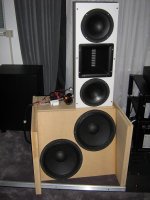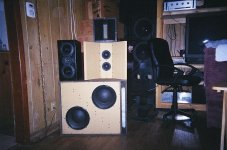RD-75's are line-sources, which is a great advantage in itself, as is almost eliminated floor and ceiling reflection.
Sure. But how about tone, naturalness/neutrality, detail, micro and macro dynamics ?
Sure. But how about tone, naturalness/neutrality, detail, micro and macro dynamics ?
Better in every way.
Mostly because of no crossovers above 200 Hz I would think.
10G40 and 10Mi100 are very good drivers. The 10G40 will give you bass down to about 55Hz. It is easy to cross over, can be used in quite different projects, so it is a great allround driver.
10Mi100 is a great midrange, and sounds a bit more dynamic than the 10G40.
Both sound very clean and I really liked them.
12P80(Nd or Fe) looks very interessting on paper and is definitly worth a closer look.
10Mi100 is a great midrange, and sounds a bit more dynamic than the 10G40.
Both sound very clean and I really liked them.
12P80(Nd or Fe) looks very interessting on paper and is definitly worth a closer look.
I wish beyma had kept the softer suspension and lower Mms of the Nd model with the new 12P80Fe instead of apparantly making it even more robust below Fs and at DC ... but besides this, the Fe looks like another killer midbass from Spain. Thanks for the pointer, Meister  (I wasn't aware of these new models)
(I wasn't aware of these new models)
- Klaus
- Klaus
There are some comments at hififorum.nu about the Beyma 12P80Nd combined with TPL-150 which are very encouraging :
maibe someone native of swedish has a better translation :
HiFiForum.nu - Två Halmstadflyttar och en björn i Nissan
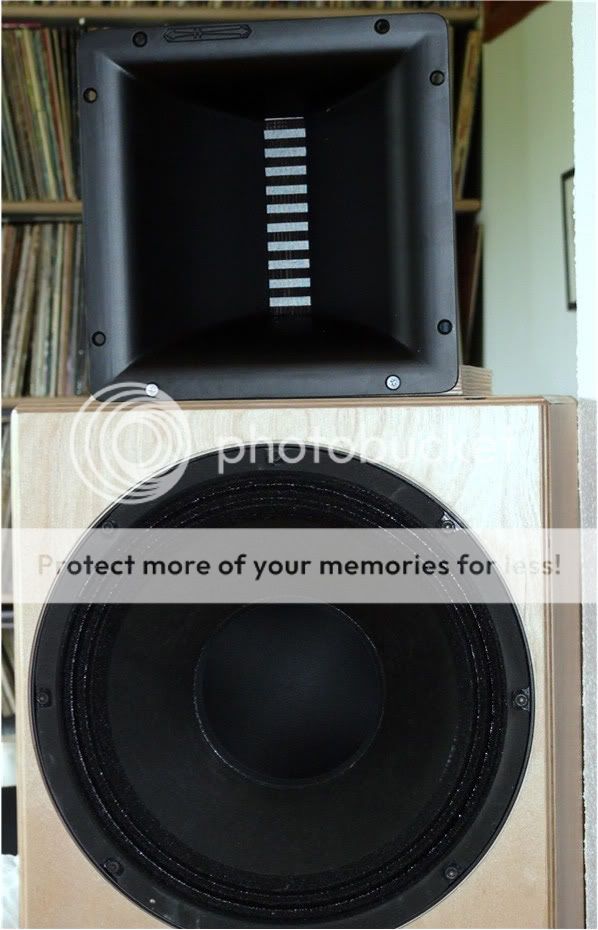
I have had time to play around with the new 12orna, . They are not even an iota of recorded yet, does not go nearly as deep as the 12P1000Ndsom sat in the same boxes two days ago. But what comes out! This is the most transient I've ever heard, with a resolution and with a tone that is purely amazing, I have not even heard a field coil element with the poise and sense of effortless at the base and the naturalness of voices and foundations in guitars and so on. I definitely think that anyone thinking of a little more TH or maybe kvartsvågspipor, or perhaps real horns, should include these elements in their thoughts. Then they can man be the foundation for a new model, a "supermoc" perhaps? TPL treble in originalmocarna included waveguide now, which enhance the sensitivity of 102dB, we need, then just find a nice 24 "or maybe 30" to the bottom? Ingvar
After a few days of listening, I think: the resolution, just like the version without the horns, incredible, välinspelade strings and percussion is ridiculous live and recordings that feels a little loud will be nicer then the element is completely free from ringing. Really bad recordings are however quite olyssningsbara when the treble is extremely revealing. Some boards feel a little # 8221, call # 8221; in the sound, probably due to the extremely low distortion, a compression driver is of course much higher 1st and 2nd harmonic distortion which adds some warmth and softness that are typically very pleasant to listen to. The combination QW-1 and the treble is really fun to listen to, now, are both basses to be recorded as well and they perform an amazing base and an addictive intimacy and life of the votes. Mathias: I have not really the plant, mocarna was too small, sometimes you could not find them if no music was played, it thus becomes larger versions, but there are advanced plans for a baby sister, mlk, (go ahead and guess! ) Hornta! Crossover 1200-1300, 2nd order LR, schedule is on PM, forgot to answer yours. Ingvar
how about a Beyma 12P80Nd to cover lower midrange, and Beyma 18P80Nd for bass duty ?
something like $100k speakers from Mark Levinson.....
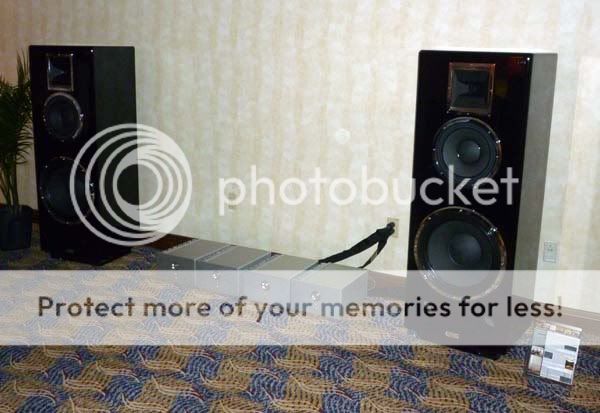
maibe someone native of swedish has a better translation :
HiFiForum.nu - Två Halmstadflyttar och en björn i Nissan

I have had time to play around with the new 12orna, . They are not even an iota of recorded yet, does not go nearly as deep as the 12P1000Ndsom sat in the same boxes two days ago. But what comes out! This is the most transient I've ever heard, with a resolution and with a tone that is purely amazing, I have not even heard a field coil element with the poise and sense of effortless at the base and the naturalness of voices and foundations in guitars and so on. I definitely think that anyone thinking of a little more TH or maybe kvartsvågspipor, or perhaps real horns, should include these elements in their thoughts. Then they can man be the foundation for a new model, a "supermoc" perhaps? TPL treble in originalmocarna included waveguide now, which enhance the sensitivity of 102dB, we need, then just find a nice 24 "or maybe 30" to the bottom? Ingvar
After a few days of listening, I think: the resolution, just like the version without the horns, incredible, välinspelade strings and percussion is ridiculous live and recordings that feels a little loud will be nicer then the element is completely free from ringing. Really bad recordings are however quite olyssningsbara when the treble is extremely revealing. Some boards feel a little # 8221, call # 8221; in the sound, probably due to the extremely low distortion, a compression driver is of course much higher 1st and 2nd harmonic distortion which adds some warmth and softness that are typically very pleasant to listen to. The combination QW-1 and the treble is really fun to listen to, now, are both basses to be recorded as well and they perform an amazing base and an addictive intimacy and life of the votes. Mathias: I have not really the plant, mocarna was too small, sometimes you could not find them if no music was played, it thus becomes larger versions, but there are advanced plans for a baby sister, mlk, (go ahead and guess! ) Hornta! Crossover 1200-1300, 2nd order LR, schedule is on PM, forgot to answer yours. Ingvar
how about a Beyma 12P80Nd to cover lower midrange, and Beyma 18P80Nd for bass duty ?
something like $100k speakers from Mark Levinson.....

I'm currently considering to use Beyma 8m70v2 as midrange with tpl-150H. The sensitivity is lower, but as my bass is also of less sensitivity than the tpl-150 I would still need to pad it down.
Tpl-150 is on its way, midranges I haven't ordered yet.
8m70v2: http://profesional.beyma.com/ingles/pdf/8M70V2.pdf
Tpl-150 is on its way, midranges I haven't ordered yet.
8m70v2: http://profesional.beyma.com/ingles/pdf/8M70V2.pdf
We (a friend of mine and me) tried quite some MF combinations with the TPL150, based on an open baffle configuration.
We tried single midrange, but in the end an MTM sounds best to our ears.
My friend has 8M70V2's, I am about to finish my rig with the 8LW30, crossover around 2k.
Pro of this MTM is that two parallelled midranges match the sensitivity of the TPL150 (no padding down of the tweeter necessary) giving a very nice system from about 200 Hz upwards with some 98 dB.
Sounds great with a tube amplifier.
Cardiole, when interested I have 4 8M60's left; these are the same as 8M70V2; only difference is that Beyma changed the chassis.
We tried single midrange, but in the end an MTM sounds best to our ears.
My friend has 8M70V2's, I am about to finish my rig with the 8LW30, crossover around 2k.
Pro of this MTM is that two parallelled midranges match the sensitivity of the TPL150 (no padding down of the tweeter necessary) giving a very nice system from about 200 Hz upwards with some 98 dB.
Sounds great with a tube amplifier.
Cardiole, when interested I have 4 8M60's left; these are the same as 8M70V2; only difference is that Beyma changed the chassis.
We tried single midrange, but in the end an MTM sounds best to our ears.
.
Good to know that.
Before, Linesource wrote :
Doug's thread "10" MTM with NeoPro5i Ribbon - Build Thread" is a good reminder of dispersion and lobing limitations in an MTM when the center-to-center spacing is greater than half the crossover frequency wavelength.
"1. Unacceptable vertical response caused by the MTM arrangement of the TD10M drivers.
The Germans do let one of the two 8" or 10" midbass drivers work up to 400hz, and the second one to crossover frequency to the TPL-150. So that evitates lobing.
I read somewhere the Beyma 10G40 matches well with TPL-150. Maibe go the
Hornet route would be the interesting, and backload one of the drivers, which would play up to 400hz:
Hornet by Michael Weides
Something like this:
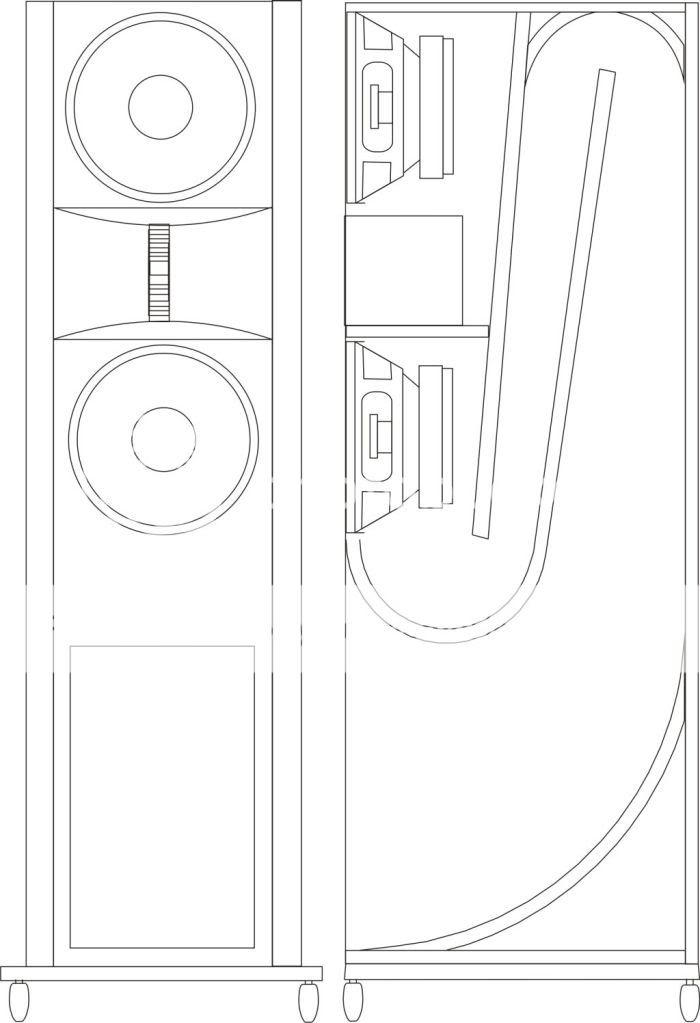
btw. i decided to keep Vitavox S2, and use the TPL-150 where the Coral tweeter used to be. Vitavox will cover a narrow range, from 500hz to 1,5khz only. I crossed the Fane Studio 8m at 500hz, and S2 up, but did not like it . let the Fane play parallel up to 1,2khz, and the Vitavox together, integrates better, and soundstage is better, than without the Vitavox. S2 is padded down with L-pad. While S2/H104 became fatiguing listening over time, with TPL-150 i can listen for hours, and i am not getting tired. What most impresses me is naturalness. Bad recordings sound bad, good ones sound good. Its amazing how it reveals things.....

Last edited:
Good to know that.
Before, Linesource wrote :
Doug's thread "10" MTM with NeoPro5i Ribbon - Build Thread" is a good reminder of dispersion and lobing limitations in an MTM when the center-to-center spacing is greater than half the crossover frequency wavelength.
"1. Unacceptable vertical response caused by the MTM arrangement of the TD10M drivers.
The Germans do let one of the two 8" or 10" midbass drivers work up to 400hz, and the second one to crossover frequency to the TPL-150. So that evitates lobing.
I read somewhere the Beyma 10G40 matches well with TPL-150. Maibe go the
Hornet route would be the interesting, and backload one of the drivers, which would play up to 400hz:
Hornet by Michael Weides
Something like this:

Yes, we know about possible lobing issues with the MTM configuration.
That's why we tried all these options, just to see (hear) if practice meets theory.
In the end however the MTM simply sounds best, and from the listening position the sound is just very coherent without pointing in the direction of these lobing issues.
D'Appolito configurations are based on point sources as far as I know.
The TPL150 as a treble unit is not a point source but will more behave like a line source for frequencies over 3 kHz or so.
The midranges are about 40 cm apart centre-centre, so there is line source behavior from a little under 1 kHz upwards.
Maybe all this is responsible for the "click" we reached with this setup.
Yes, we know about possible lobing issues with the MTM configuration.
That's why we tried all these options, just to see (hear) if practice meets theory.
In the end however the MTM simply sounds best, and from the listening position the sound is just very coherent without pointing in the direction of these lobing issues.
D'Appolito configurations are based on point sources as far as I know.
The TPL150 as a treble unit is not a point source but will more behave like a line source for frequencies over 3 kHz or so.
The midranges are about 40 cm apart centre-centre, so there is line source behavior from a little under 1 kHz upwards.
Maybe all this is responsible for the "click" we reached with this setup.
Mr.Achenbach, which sells the SON-B , made comparisons between the two configurations. One , using one driver only up to 400hz, and the second, using both drivers up to crossover frequency of the Beyma AMT. He reported no relevant perceivable difference.
Mr.Achenbach, which sells the SON-B , made comparisons between the two configurations. One , using one driver only up to 400hz, and the second, using both drivers up to crossover frequency of the Beyma AMT. He reported no relevant perceivable difference.
Interesting that our experience is confirmed.
The nice thing with both midrange speakers working up to the same crossover is that it matches the sensitivity of the TPL150, so it not only eases the crossover network but not having to attenuate the TPL150 is good for sound quality.
By the way, our setup is open baffle woofer - MTM bi-amplified.
By the way, our setup is open baffle woofer - MTM bi-amplified.
Any pictures?
The Germans do let one of the two 8" or 10" midbass drivers work up to 400hz, and the second one to crossover frequency to the TPL-150. So that evitates lobing.
would play up to 400hz:
I would expect a traditional TMW speaker stack with the T=TPL150, M= 8" midbass, and W=18" to perform better. For WAF, the pipe stand on the German MTM would likely get a lower rating that a bass cabinet.
I'm still a fan of using a wide bandwidth midbass to cover more of the vocal range, roughly 80 Hz to 1100 Hz (that is, E2 to C6) for normal male and female voices together.
There are several physical limitations in using one standard speaker over a wide bandwidth.
1) Frequency response and quality of sound.
2) horizontal and vertical polar response (beaming)
3) IMD Intermodulation distortion (doppler) from summing low and high frequencies
4) adequate SPL levels
STILL.. there is a large full range speaker group that accepts these compromises over crossovers.
When you run through the equations, it looks like 3-way with an 8" or 10" midbass speaker is the best option to cover a low of (80-100Hz) to a high of (1,200, 1,500Hz). IMD start to increase rapidly even with the xover dropping just from 100 to 80Hz. Constant directivity degrades rapidly with the xover increasing from 1,000 to 1,500Hz. A midbass with a curvelinear cone profile has ~10% superior directivity.
Several 98-100 db/watt high efficiency old school speakers with a 300Hz crossover used two 15" woofers, a 10" midbass like the JBL 2012H, and a 1" compression driver with a 90 x 40 constant directivity horn. I have found that accepting a 94-95 db/watt SPL efficiency and a 1,400-1,600Hz crossover to a suitable tweeter allowed me to use a light cone 8" midbass to pull detail over the vocal_range, or a 10" midbass to put more weight behind vocals with additional compromise in dispersion. I have Tang Band W8-1808 and Lambda TD10M.
As you would expect, a full range 8" with decent Xmax can be used as a wide bandwidth, good dispersion midbass.
Off set bass drivers
I like the way you have your bass (or in my case mid-bass) drivers off set.
I used this same approch a few years ago, and intend on going back to it. Sounded really nice.
(ps disregard the MTM video speakers in the pic, and then notice the similarities)
Here is my friends set up; open baffle bass still under development.
He prefers the TPL150 horn loaded (actually more a waveguide); I prefer it without.
I like the way you have your bass (or in my case mid-bass) drivers off set.
I used this same approch a few years ago, and intend on going back to it. Sounded really nice.
(ps disregard the MTM video speakers in the pic, and then notice the similarities)
Attachments
I like the way you have your bass (or in my case mid-bass) drivers off set.
I used this same approch a few years ago, and intend on going back to it. Sounded really nice.
(ps disregard the MTM video speakers in the pic, and then notice the similarities)
In this situation the woofer offset is done to limit total height of the complete rig.
Maybe some kind of U or H frame might have done the bass job, but I am not sure if that sounds good up to some 200 - 250 Hz.
cross-over frq
In the system pictured above, that was crossed at 500Hz then feeding the twin 5inchers in that waveguide. 500 Hz = 2 feet, and the 2 drivers are within that distance as well as the distance to the above mid. That's why I offset the drivers in that particular system.
Since then, however, I have lowered the x-over to 250hz and changed over to a single 10" midrange. The 10 inch moves a lot more air, which IMO is required at that low of a crossover frequency. I am mulling over whether to lower the x-over freqency even more, say to 190Hz.
In this situation the woofer offset is done to limit total height of the complete rig.
Maybe some kind of U or H frame might have done the bass job, but I am not sure if that sounds good up to some 200 - 250 Hz.
In the system pictured above, that was crossed at 500Hz then feeding the twin 5inchers in that waveguide. 500 Hz = 2 feet, and the 2 drivers are within that distance as well as the distance to the above mid. That's why I offset the drivers in that particular system.
Since then, however, I have lowered the x-over to 250hz and changed over to a single 10" midrange. The 10 inch moves a lot more air, which IMO is required at that low of a crossover frequency. I am mulling over whether to lower the x-over freqency even more, say to 190Hz.
- Home
- Loudspeakers
- Multi-Way
- Best midrange to pair with Beyma TPL-150
